Synonyms
Orcus cyanocephalus Mulsant, 1850: 467.
Orcus Lecanii Blackburn, 1895: 239..
Orcus purpureotinctus Lea, 1902: 490.
Diagnosis
This species is separable from O. lafertei only by the lack of true metallic reflection on the elytra, which can be black, purple or green. Male genitalia are practically identical in this species complex.
Description
Length 3.5-4.5 mm. Male. Dorsal surface varying from blue, purple or darkish-brown with varying degree of shine; venter pale brown except for epipleura and lateral extremity of hypomera, which are dark brownish. Body rounded, convex. Head micro reticulate between punctures; punctation about as large as eye facets, not conspicuously deep and somewhat sparse, nearly 2 diameters apart. Eyes with inner margin slightly diverging apically. Clypeus weakly emarginate. Antennae 9-segmented, very similar to O. lafertei. Maxillary and labial palpomeres also very similar to O. Lafertei. Pronotal surface sculptured as on head, the sculptures much weaker; punctation slightly larger than eye facets, as shallow as on head but more concentrated, approximately 1 diameter apart; the punctures confluent on anterior angles; anterior angles with distinct strigae; lateral borders somewhat oblique; bordering line interrupted at base, the line slightly bent at the lateral border (in some specimens); prosternum moderately long in front of coxae about 1.5 times longer than the prosternal process widest width; hind tibiae with outer tooth; tarsal claws distinctly appendiculate. Elytral surface sculptured as on pronotum; punctation weaker than on pronotum, slightly shallower and sparser; lateral margin weakly reflexed, without clear bead; epipleural foveae conspicuous. Abdomen with 6 ventrites; 6th very reduced, straight to slightly emarginate at apex; surface of ventrite 1 polished between postcoxal lines; postcoxal lines joined at middle, running parallel to posterior margin of ventrite, almost reaching lateral margin; apical border of intercoxal process conspicuously swollen.
Male
Tegmen relatively short, about 1/3 the abdomen length; penis guide symmetrical, slightly longer than parameres; parameres densely setose at apex, the setae long; strut as long as tegmen; penis as figured.
Female
Female externally similar to male, except having only 5 visible abdominal ventrites, the 5th ventrite also rounded but longer than in male, about 2 times longer than 4th, somewhat oval.
Variation
Unknown.
 Distribution and Biology
Distribution and Biology
This species is widely distributed in northern parts of Australia (Fig. 206) and New Guinea. Fedding on various scale insects.
Species References
Blackburn, T. 1895. Further notes on Australian Coleoptera, with descriptions of new genera and species. XVIII. Transactions of the Royal Society of South Australia, 19: 201-258.
Mulsant, E. 1850. Species des Coléoptères Trimères Sécuripalpes. Annales des Sciencies Physiques et Naturelles, díAgriculture et díIndustrie, publiées par la Société nationale díAgriculture, etc., de Lyon, Deuxième Série, 2: xv + 1-1104.
Lea, A. M. 1902. Descriptions of new species of Australian Coleoptera. Proceedings of the Linnean Society of New South Wales, 1901: 481-513.
Slipinski, S.A. 2007. Australian Ladybird Beetles (Coleoptera: Coccinellidae) their biology and classification. ABRS, Canberra. 286 pp.
Slipinski, A. and Giorgi, J.A. 2006. Revision of the Australian Coccinellidae (Coccinellidae). Part 6. Tribe Chilocorini. Annales Zoologici (Warszawa), 56(2): 265-304.
[ Top ]
